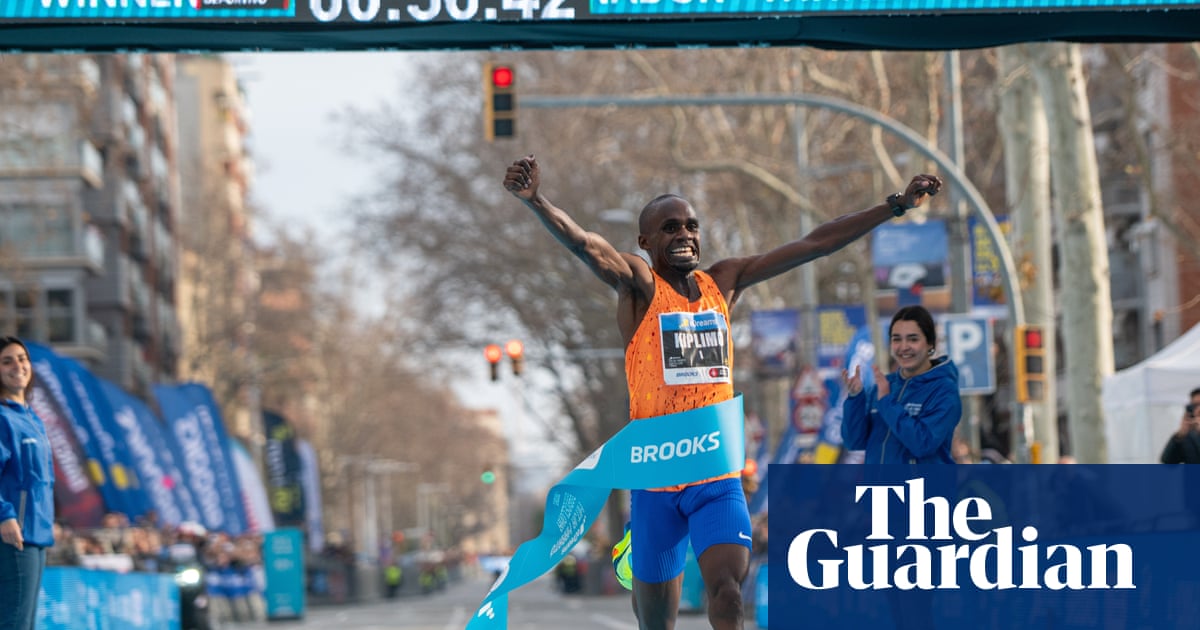Earlier this year Jacob Kiplimo produced a performance so staggering that it sent the jaws of even seasoned track and field watchers crashing to the floor. It came on the streets of Barcelona, where the 24-year-old Ugandan covered 13.1 miles in 56min 42sec – a half marathon time 48sec quicker than anyone else in history.
Little more than two months later, Kiplimo is in London for his full marathon debut and the noise has only grown louder. Could he break the world record on Sunday? Could he even become the first man to break two hours in an official race? It is speculation that the event director, Hugh Brasher, is more than happy to stoke.
“I think it’s going to be the most fascinating debut ever,” he says. “Is it feasible that he could take Kelvin Kiptum’s record as the fastest debutant? Without a doubt. Do I think he could one day be the athlete that runs under two hours? Yes. But let’s see what happens on Sunday.”
Kiplimo was regarded as a superstar in waiting even before he competed over 5,000m as a 15-year-old prodigy at the 2016 Rio Olympics. He had a humble upbringing on a farm in Kween, 1500m above sea level on the Mount Elgon volcano. But, because his father had three wives, he had many older half-brothers to run with – including Robert Chermonges and Victor Kiplangat, both of whom have gone on to be sub 2hr 10min marathoners – and soon proved to be something special.
“We were helping our brothers, the big brothers,” he says. “They were running and we kept seeing them when they were training. And one day, I tell them, ‘I want to become like you.’ So I just kept training, training. This was when I was around 10 or 11.”
A few years later Kiplimo was spotted and brought to Italy to train for the 2016 Olympics. “Afterwards my coach, Giuseppe Giambrone, said to me ‘you will be one of the greatest runners in the world,’” says Kiplimo. “It ended in the semi-finals. But it was a huge experience for me to be at the Olympics.”
Kiplimo’s staggering performances as a 15-year-old included running the 5,000m in 13:19.54 and the 10,000m in 27:26.28 – all in the era before supershoes. But despite going on to win two senior world cross country titles as well as Olympic and world 10,000m bronze medals, his lack of a devastating sprint finish ended up hurting him on the track.
On the roads it has so far been a different story. But on Sunday he faces the moment of truth against one of the greatestLondon Marathonfields ever assembled. It includes Eliud Kipchoge, the greatest of all time. The Olympic champion, Tamirat Tola. Last year’s winner, Alexander Mutiso. And the well-fancied Sabastian Sawe, a late bloomer at 30 who ran 2:02:05 to win the Valencia marathon in December, the second-fastest debut in history. British eyes, meanwhile, will also be focused on Olympic triathlon gold medallist Alex Yee, who hopes to run around 2:09 in his debut over 26.2 miles.
“I am ready to compete,” says Kiplimo, who reveals that he feels much stronger having gone from running around 75-90 miles a week during his track career to more like 125-135 for the marathon.
The leading pack is likely to go through halfway in 61min, giving scope for Kiplimo to run a negative split and chase down Kiptum’s world record of 2:00:35. A following wind for the second half of the race will help, although the forecast may be a little warm.
When asked whether he could one day break two hours for the marathon, Kiplimo is cautious – at least for now. “Yes, of course,” he says. “Maybe in the future. But I’m just focusing on my debut. If this one goes well, then maybe I will be the guy to make it.”
Inevitably, Kiplimo’s record-breaking times have aroused some suspicion – especially given the number of east Africans who have been caught doping over the past decade. In online forums, it is also noted that his agents, Rosa and Associati, have had previous clients test positive for EPO – including the 2016 Olympic marathon champion, Jemima Sumgong, and Rita Jeptoo, who won twice in Boston.
Those cases led toFrederico Rosa being investigated by the Kenyan governmentin 2016, before all charges were dropped. Afterwards, Rosa’s lawyer insisted that the government did “not have an iota of evidence against my client,” and Kiplimo promises that he and his team can be trusted.
Sign up toThe Recap
The best of our sports journalism from the past seven days and a heads-up on the weekend’s action
after newsletter promotion
“Rosa is a good company,” he says. “We always use supplements that are recognised. For me, I can’t say nothing about doping, but I train myself. And I believe in my training. They give us a lot of advice. They tell us, in case of anything, you have to write everything down that you are taking. Some athletes want shortcuts. But for us we keep following the programme.”
“Can we trust you and believe in you?” he is asked.
“Yes, of course,” comes the reply.
“A man that has run 56.42 for a half marathon?”
“Yes, of course.”
Kiplimo’s answers were as emphatic as he hopes his performance will be on Sunday. He is particularly excited to face Kipchoge, who he helped pace to a sub two-hour marathon in Vienna in 2019, albeit in a race which didn’t qualify for a world record under World Athletics’ rules.
“I remember 2019, when I was pacing Kipchoge,” he says. “So for me it is a little bit amazing to compete with one of the greatest runners in history.” And, he hopes, to make some more history of his own.
